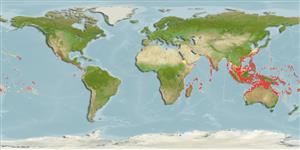>
Aulopiformes (Grinners) >
Synodontidae (Lizardfishes) > Synodontinae
Etymology: Synodus: Greek, syn, symphysis = grown together + Greek, odous = teeth (Ref. 45335); jaculum: jaculum (neuter noun in apposition) from the Latin word for javelin, in reference to the peculiar behavior of this species of launching itself off the bottom and swimming in midwater for prolonged periods..
Environment: milieu / climate zone / depth range / distribution range
Ökologie
seewasser riff-verbunden; tiefenbereich 2 - 100 m (Ref. 11228). Tropical; 33°N - 32°S
Indo-Pacific: East Africa to the Line, Marquesan, and Society islands, north to the Izu Islands (Japan), south to New South Wales (Australia); Palau to Kosrae in Micronesia.
Size / Gewicht / Alter
Maturity: Lm ? range ? - ? cm
Max length : 20.0 cm TL Männchen/unbestimmt; (Ref. 2334); common length : 10.0 cm TL Männchen/unbestimmt; (Ref. 3520)
Rückenflossenstacheln (insgesamt): 0; Rückenflossenweichstrahlen (insgesamt): 11-13; Afterflossenstacheln 0; Afterflossenweichstrahlen: 8 - 10. Body brownish above, with dark brown saddle blotches; fins transparent, with faint brown spots on dorsal and caudal rays (Ref. 11228). Prominent black blotch on its caudal peduncle (Ref. 1602).
Inhabits coral reefs. Commonly found on sand or rubble near coral heads. Feeds on shrimps and small fishes (Ref. 89972). Frequently caught with S. variegatus and S. englemani, using artisanal gear and trawls. Sold fresh and dried salted in markets. Solitary,in pairs or in small groups (Ref 90102).
Life cycle and mating behavior
Geschlechtsreife | Fortpflanzung | Ablaichen | Eier | Fecundity | Larven
Cressey, R.F. and R.S. Waples, 1984. Synodontidae. In W. Fischer and G. Bianchi (eds.) FAO species identification sheets for fishery purposes. Western Indian Ocean (Fishing Area 51). Volume 4. FAO, Rome. (Ref. 3520)
IUCN Rote Liste Status (Ref. 130435)
Bedrohung für Menschen
Harmless
Nutzung durch Menschen
Fischereien: weniger kommerziell
Mehr Information
NamenSynonymeMetabolismusRäuberÖkotoxikologieFortpflanzungGeschlechtsreifeAblaichenSpawning aggregationFecundityEierEientwicklung
ReferenzenAquakulturAquakultur ProfilZuchtlinienGenetikElectrophoresesVererbbarkeitKrankheitenVerarbeitungNutrientsMass conversion
PartnerBilderStamps, Coins Misc.LauteCiguateraGeschwindigkeitSchwimmstilKiemenoberflächeOtolithsGehirngrößeSehfähigkeit
Tools
Zusatzinformationen
Download XML
Internet Quellen
Estimates based on models
Preferred temperature (Ref.
123201): 24.5 - 29, mean 27.9 °C (based on 1488 cells).
Phylogenetic diversity index (Ref.
82804): PD
50 = 0.5000 [Uniqueness, from 0.5 = low to 2.0 = high].
Bayesian length-weight: a=0.00447 (0.00211 - 0.00945), b=3.16 (2.99 - 3.33), in cm total length, based on LWR estimates for this Genus-body shape (Ref.
93245).
Trophic level (Ref.
69278): 4.0 ±0.7 se; based on size and trophs of closest relatives
Widerstandsfähigkeit (Ref.
120179): hoch, Verdopplung der Population dauert weniger als 15 Monate. (Preliminary K or Fecundity.).
Fishing Vulnerability (Ref.
59153): Low vulnerability (10 of 100).
Nutrients (Ref.
124155): Calcium = 72.4 [26.5, 161.1] mg/100g; Iron = 0.612 [0.207, 1.325] mg/100g; Protein = 15.9 [12.9, 18.3] %; Omega3 = 0.072 [0.025, 0.182] g/100g; Selenium = 34.5 [13.4, 82.8] μg/100g; VitaminA = 115 [29, 384] μg/100g; Zinc = 1.04 [0.59, 1.60] mg/100g (wet weight);
